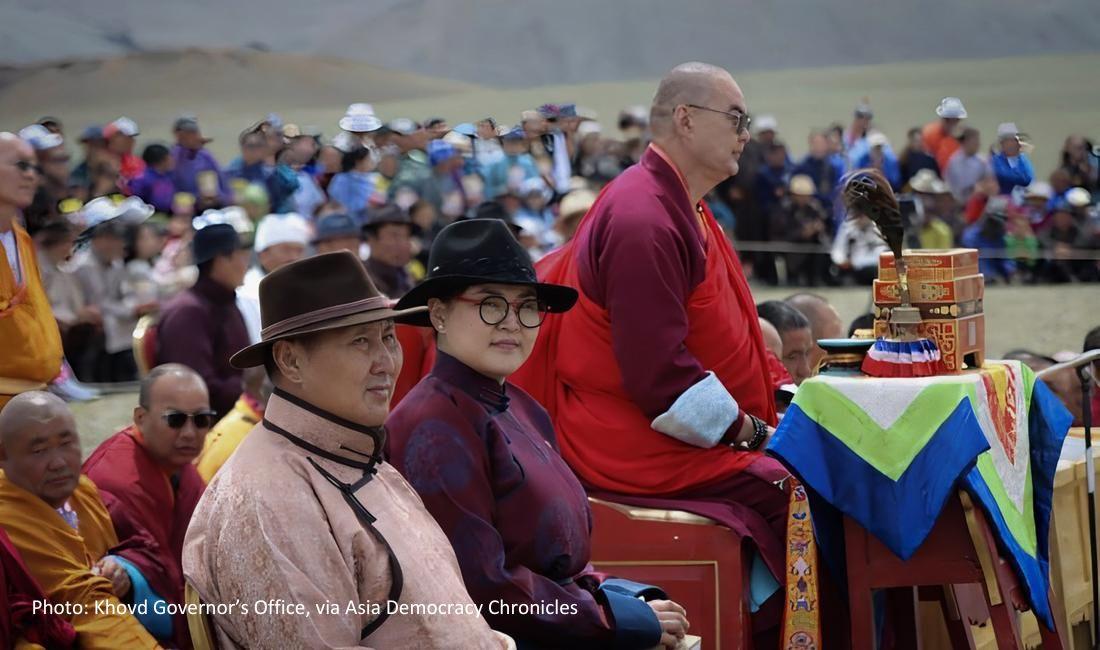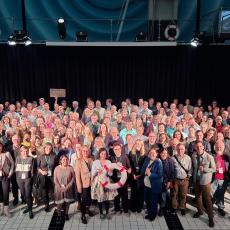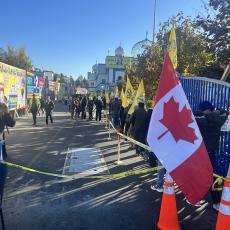Not enough Mongolian women are being elected to local office
This story was produced and published by Asia Democracy Chronicles. Photo: Khovd Governor’s Office, via Asia Democracy Chronicles
Enkhbat Bolormaa was drenched from the heavy rain and hail as she ascended Altan Khukhii mountain in Mongolia’s western province of Khovd. Strong winds were blowing as well as she climbed up, adding to Bolormaa’s unease and nervousness. The higher she went, the more she felt as if she were violating something sacred by being there.
By Mongolian tradition, women are not supposed to ascend high mountains. But as governor of Khovd, it was Bolormaa’s duty to be on top of Altan Khukhii, where she was to deliver the opening words to start a ritual rite – yet another point of dilemma for her.
In Mongolia, political leaders are obligated to take part in local Buddhist spiritual rituals. These rituals can be as mundane as going to one of the highest peaks in the region and soaking in the first sunlight from the rising sun. Women, however, are excluded from taking part in these ceremonial acts.
Thus for decades, female leadership, however small, was excluded from these ceremonies. And in the few instances that women have managed to reach high government posts, they have found themselves caught between their official duties that include participating in such rituals and long-standing cultural norms.
Mongolian rituals like fire and mountain worship hold great cultural significance, symbolizing the nation’s deep reverence for nature and ecological balance. These practices were suppressed during Mongolia’s communist period, which began in 1921 and lasted until the 1990s.
Today the country’s traditional practices of worshipping sacred sites are among those listed by the UNESCO as intangible cultural heritage in need of immediate protection. Far from mere superstitions, they are integral to Mongolia’s cultural identity and environmental ethos.
That these rites traditionally bar women from participating, however, clashes with current views on gender equality. Indeed, the exclusion of women from such significant practices could be seen as limiting women’s participation in government affairs and excluding them from important political processes. Mongolia even has a law that mandates the President of Mongolia or a high-ranking state official to lead these traditional spiritual ceremonies.
For female politicians, it can feel like being forced to choose between social ostracism for breaking traditions and failing to fulfill part of their official duties by not showing up in functions that they are required to attend. But while Mongolian society remains patriarchal, its people appear willing to consider the demands of a modern, equitable society, even as it holds on to its rich cultural history. This includes having women leaders participate in sacred rituals that by tradition are for men only.
“Mongolians, as a nomadic society, have always maintained an egalitarian way of life,” says Davaasuren Enkhjargal, national coordinator of MONFEMNET National Network, a coalition of 16 women’s organizations working to strengthen the rights of Mongolian women and marginalized groups.
“However, as a result of foreign cultural influences, we have lost this essence of ourselves. Now there is a further significant change in that more people are becoming inclined to the concept of women assuming leadership positions,” she says. “There are still obstacles, but there is some progress.”
Top-of-the-world moment
And so in July last year, Bolormaa found herself standing atop Altan Khukhii, leading the “State Worship Ceremony of Sacred Mountains and Ovoos (stone cairns),” which is performed every five years at each of several state-recognized sacred mountains across Mongolia.
The ceremony is regulated by law, which specifies that it must be directed by the governor of the respective province. The President of Mongolia, or a state representative appointed by the President (at the ministerial level or above), leads the ceremony. High-ranking officials from the province, such as the Chairperson of the Citizens’ Representative Khural, also attend.
During the ceremony, the Mongolian national anthem is played, a presidential message is delivered, and offerings are made to the mountain’s spirit. The event also includes traditional Mongolian sports such as wrestling, horse racing, and archery.
Revering mountains among Mongolians dates back to the 13th century when Chinggis Khan, the founder of the Mongol Empire, decreed that Burkhan Khaldun mountain (his birthplace) should be worshipped. But the exclusion of women from the ritual appears to be not due to their gender per se. Rather, it was because of health concerns, as folk wisdom deemed high altitudes to have negative effects on women’s reproductive health.
While this has since been borne out by modern science, research has shown that high altitudes could also have a negative health impact on men, including on their reproductive functions. Then again, there are mountain communities across the globe where people have been able to live and grow their families without much problem.
In any case, when Bolormaa became Mongolia’s first female provincial governor in September 2022, she was aware that her gender might conflict with her responsibility as a leader and affect how the public would treat her. She would tell Asia Democracy Chronicles (ADC) later that she accepted the notion that she might not be able to fulfill all her duties out of respect for tradition.
Bolormaa believes in respecting customs, regardless of how it may inconvenience her. But as it turned out, it was not only the state leadership that wanted her to proceed with traditional rites like the worship ceremony on Altan Khukhii; the local leadership also wanted her to be part of these rituals.
She recounted how all of her worries vanished when it rained. “[Mongolians] believe rain can be an auspicious moment,” she told ADC. “And when it rained like it did, I knew the land and mountain accepted my presence.”
Avoiding a clash
According to Bolormaa, she has noticed that while Mongolians want to uphold customs, they also respect hierarchy. She recounted an instance when duty called and she had to give awards to herders at their houses.
The herders had set a ceremonial table with a full mutton’s back, a highly esteemed dish. Typically, the visiting official is required to demonstrate respect by being the first to cut the mutton’s back during the ceremony.
Again, women are usually not permitted to do this, so Bolormaa tackled the complex situation with prudence. She recalled, “When I went into their homes, I suggested that the male district chief or the head of the household should cut it first, but they kept saying I should do it instead.”
Bolormaa used the same approach in another similar situation. “The head of the family, an elderly man, said, ‘No, we have prepared this mutton’s back to honor the state, so you must cut it’,” she told ADC.
These incidents, Bolormaa said, demonstrate how some people are prepared to break traditions to honor both culture and government roles. “This is not a written law,” she added, “so it was more about feeling the situation and responding accordingly.”
In truth, the practice of barring women from sacred rituals had been challenged in court decades before. In 2011, women – including legislators and journalists – were excluded from the “State Fire Ceremony” held at the Government Palace. This exclusion prompted concern from women’s rights organizations, which viewed it as a violation of the Constitution and yet another example of discrimination against women.
Jurmed Zanaa, head of the Centre for Citizens’ Alliance, brought the matter before the Constitutional Court of Mongolia. But the Court stated that the ceremony did not violate the law, basing its ruling on cultural and traditional practices.
Sparse representation
These days, with Mongolians seemingly more flexible about female participation in traditional ceremonies, women’s rights advocates are hoping to see similar forward thinking to lead to more female presence in government.
MONFEMNET’s Enkhjargal contends that without inclusive representation, women must battle tooth and nail to have their opinions heard, particularly when women have been barred from so many venues conducive to discourse.
“In a period when women’s representation in politics is insufficient, it is critical that women participate in any political discussions,” Ehkhjargal said. “Unfortunately, women do not have the luxury of participating in such talks because of their responsibilities as mothers and wives, as well as how they will be seen on specific occasions.”
Indeed, since Mongolia’s transition to democracy, the journey of women’s representation in the country’s parliament has been uneven. Starting with just 3.9 percent in 1992, the percentage of women members in the State Great Khural peaked at 11.8 percent in 2000, before declining to 3.9 percent again in 2008.
Thanks to civil society organizations demanding more women legislators, it was later mandated that at least 20 percent of candidates nominated by parties and coalitions be of either gender. This led to a consistent upward trend of women in parliament beginning in 2012, when their number reached 13 in the State Great Khural (17 percent of the then 76 total members), and which held steady until 2020. Yet while this represented progress, it still fell short of global averages and Mongolia’s own legal quotas.
n 2023, civil society groups, among them MONFEMNET, were successful in campaigning for a 30 percent quota for women in parliament. Looking ahead, Mongolia has set an even loftier goal: beginning in 2028, a 40 percent quota for female candidates in parliamentary elections will be enforced, potentially paving the path for additional rises in women’s representation.
But ambitions do not necessarily become reality. While last June’s parliamentary election led to 32 women becoming part of the 126-member State Great Khural, this translates to a 25.4-percent female representation in parliament, which is obviously less than the quota.
The June election also left Mongolia with no female provincial governor, since Bolormaa ran for parliament and was successful. The country also lost its lone female district governor to the State Great Khural.
If Mongolia’s sacred rituals become strictly male affairs once more, it may not be because Mongolians decided to cling tighter to traditions. It could simply be a matter of having too few women leaders who would be required to participate in them



